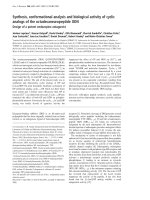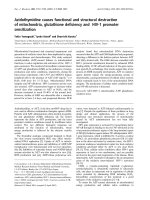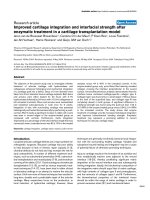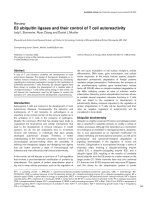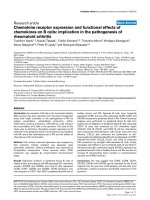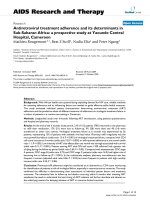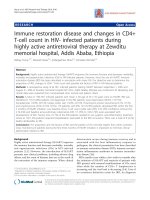Báo cáo y học: "Impaired nuclear import and viral incorporation of Vpr derived from a HIV long-term non-progressor" docx
Bạn đang xem bản rút gọn của tài liệu. Xem và tải ngay bản đầy đủ của tài liệu tại đây (870.73 KB, 7 trang )
BioMed Central
Page 1 of 7
(page number not for citation purposes)
Retrovirology
Open Access
Short report
Impaired nuclear import and viral incorporation of Vpr derived
from a HIV long-term non-progressor
Leon Caly
1
, Nitin K Saksena
2
, Sabine C Piller
3,4
and David A Jans*
1
Address:
1
Department of Biochemistry and Molecular Biology, Monash University, Clayton, Victoria 3800, Australia,
2
Retroviral Genetics Division,
Centre for Virus Research, Westmead Millennium Institute, Westmead Hospital, The University of Sydney, Darcy Road, Westmead, N.S.W 2145,
Australia,
3
HIV Protein Function and Interactions Group, Centre for Virus Research, Westmead Millennium Institute, Westmead Hospital, The
University of Sydney, Darcy Road, Westmead, N.S.W 2145, Australia and
4
University of Western Sydney, Penrith South DC, N.S.W 1797, Australia
Email: Leon Caly - ; Nitin K Saksena - ; Sabine C Piller - ;
David A Jans* -
* Corresponding author
Abstract
We previously reported an epidemiologically linked HIV-1 infected patient cohort in which a long-
term non-progressor (LTNP) infected two recipients who then exhibited normal disease
progression. Expression of patient-derived vpr sequences from each of the three cohort members
in mammalian cells tagged with GFP revealed a significant reduction in Vpr nuclear import and
virion incorporation uniquely from the LTNP, whereas Vpr from the two progressing recipients
displayed normal localisation and virion incorporation, implying a link between efficient Vpr nuclear
import and HIV disease progression. Importantly, an F72L point mutation in the LTNP was
identified for the first time as being uniquely responsible for decreased Vpr nuclear import.
Findings
The highly conserved HIV accessory protein Viral Protein
R (Vpr) is vital for HIV infection and replication in vivo,
particularly within non-dividing cells, including termi-
nally differentiated T-cells and macrophages where
nuclear envelope integrity is permanently maintained [1-
5]. On its own and within the context of HIV infection
[6,7], Vpr has been shown to localize to the nucleus and
induce G
2
cell-cycle arrest through hyperphosphorylation
of p34-cdc2, which provides the most optimal environ-
ment for viral replication [8-13], followed closely by
apoptosis [14-21]. During HIV infection, Vpr associates
with the viral cDNA containing Pre-integration Complex
(PIC) increasing its affinity for components of the cellular
nuclear import machinery [22-25] through the activity of
2 distinct nuclear localization signals (NLSs) within its N-
[26] and C-termini [27], thus driving productive HIV
infection.
We previously reported [28] on a cohort spanning 1992 to
2000, comprising an HIV
+
long-term non-progressor
(LTNP) (donor A) and two recipients (B and C) who upon
transmission (autumn and summer 1989 respectively)
from donor A progressed to AIDS. Vpr sequences derived
from HIV pro-viral DNA isolated from PBMCs as well as
circulating virus, revealed that sequences from the pro-
gressing recipients differed markedly to those of the LTNP
founder virus host, providing the first evidence for Vpr
positive selection during disease progression in an epide-
miologically-linked cohort (see also [29]).
In this study, cohort-derived GFP-Vpr mammalian cell
expression vectors were used to investigate Vpr subcellular
Published: 18 July 2008
Retrovirology 2008, 5:67 doi:10.1186/1742-4690-5-67
Received: 18 January 2008
Accepted: 18 July 2008
This article is available from: />© 2008 Caly et al; licensee BioMed Central Ltd.
This is an Open Access article distributed under the terms of the Creative Commons Attribution License ( />),
which permits unrestricted use, distribution, and reproduction in any medium, provided the original work is properly cited.
Retrovirology 2008, 5:67 />Page 2 of 7
(page number not for citation purposes)
localisation and nuclear import. In total, 4 HIV-1 vpr
clones were isolated from donor A (A1, A3, A5 and A6 cor-
responding to years 1996, 1998, 1999 and 2000), 4 from
recipient B (B3, B4, B5 and B6 corresponding to years
1997, 1998, 1998 and 1999) and 7 from recipient C (C2,
C3, C5, C6, C8, C10 and C11 from 1992, 1992, 1993,
1994, 1994, 1998 and 1999 respectively) and used to gen-
erate the GFP-Vpr expression constructs. Lipofectamine™
2000 (Invitrogen) was used to transfect constructs into
HeLa and COS-7 (not shown) cells, followed by imaging
14 hours post transfection using an Olympus FV-1000
confocal laser scanning microscope (CLSM), with similar
results. Initial analysis of late-stage vpr gene products from
all 3 donors revealed a reduction in nuclear fluorescence
accompanied by perinuclear accumulation for LTNP sam-
ple A6-2 (patient A, time-point 6, clone #2) (Fig. 1A(iii))
compared to pUC18-NL4.3 derived [30] wild-type GFP-
Vpr
1–96
(Fig. 1A(ii)): a phenotype not observed in samples
from patients B (B6-4) nor C (C11-1) (Fig 1A(iv, v)).
Quantification of nuclear import was determined using
ImageJ analysis software [31] where the ratio of nuclear
(Fn) to cytoplasmic (Fc) fluorescence, subtracting back-
ground (B) was calculated, Fn/c = (Fn-B)/(Fc-B). A highly
significant (p < 0.0001) reduction in Fn/c was observed
between GFP-Vpr
1–96
(Fn/c ~2.4) and GFP-Vpr
A6-2
(Fn/c
~0.9) indicating a reduction in nuclear accumulation. No
significant difference in Fn/c was observed between GFP-
Vpr
1–96
and GFP-Vpr
B6-4
or GFP-Vpr
C11-1
(Fig. 1B).
To establish if decreased Vpr nuclear accumulation was a
specifically conserved viral feature of the LTNP or an
acquired trait, GFP-Vpr constructs from early-cohort time-
points were analysed. Samples from 1996 (GFP-Vpr
A1-2
)
and 1998 (GFP-Vpr
A3-1
) (Fig. 1A(vi, vii)) both displayed
levels of nuclear accumulation comparable to wildtype
GFP-Vpr
1–96
(Fig. 1B), implying that loss of nuclear
import occurred post 1998.
With the loss of efficient nuclear accumulation identified
as a late-stage LTNP trait, further analysis of late-stage
clones A6-3 and A6-5 (clone A6-5 data not shown as
sequence is homologous to A6-3) was performed, revealing
Fn/c values significantly lower than wildtype GFP-Vpr
1–96
(Fig. 1B). Of interest, a single late-stage clone (GFP-Vpr
A6-
4
) displayed a small degree of nuclear accumulation (Fig.
1A(ix)), although at levels significantly reduced compared
to wildtype (Fig. 1B). Sequence analysis revealed that all
clones with reduced nuclear accumulation (Vpr
A6-2
and
Vpr
A6-3/5
) contained a phenylalanine to leucine mutation
at amino acid position 72 (F72L) (Fig. 1C). This mutation
is absent in the nuclear localizing Vpr
A6-4
, which is other-
wise identical in sequence to late-stage samples Vpr
A6-3/5
.
Analysis of our database containing over 1200 published
and unpublished Vpr sequences revealed that the F72L
mutation has only been reported once previously [32].
To determine the specific role of F72L in abrogation of
Vpr nuclear import, an F72L substitution was engineered
into wildtype Vpr and an expression construct (GFP-
Vpr
F72L
) produced. Subsequent transfection (Fig. 1A(x))
revealed a reduction in GFP-Vpr
F72L
nuclear accumulation
when compared with wildtype GFP-Vpr
1–96
(Fig. 1A(ii)),
in a similar fashion to clinically derived GFP-Vpr
A6-2
(Fig.
1B), thus confirming F72L as a probable mechanism for
the observed reduction in nuclear accumulation within
late-stage LTNP samples. This reduction in nuclear import
was accompanied by an accumulation of GFP-Vpr protein
within the perinuclear region of the cell, concordant with
an area encompassing the proposed location of the Golgi.
Colocalisation studies with the Golgi-specific marker pro-
tein γ-adaptin revealed that Vpr proteins harbouring the
F72L point mutation, but not those with wildtype pheny-
lalanine, were localized to the Golgi apparatus, implying
that reduced nuclear accumulation could in part be attrib-
uted to this mislocalisation of GFP-Vpr (see Additional
file 1). The lack of colocalisation between F72L-contain-
ing Vpr proteins and the endoplasmic reticulum (ER)
marker Calnexin (Sigma, C-4731), confirmed that Vpr
mislocalisation to the Golgi is not a result of general mis-
targeting (see Additional file 2).
Although the precise pathways involved are still debated,
efficient nuclear export [33] and/or cytoplasmic retention
[34] of Vpr during viral infection has been identified as a
key requirement for virion incorporation. With this in
mind, we assessed the ability of nuclear import-inhibited
cytosolic GFP-Vpr
F72L
to incorporate into forming virions.
Briefly, 293T cells were cotransfected with a panel of GFP-
Vpr expression vectors as well as the proviral plasmid
pUC18-NL4.3, with the resultant virions analysed by
Western blotting for GFP-Vpr incorporation. Interestingly
we found that all F72L-containing GFP-Vpr proteins that
failed to significantly localize within the nucleus, were
absent from purified viral lysates (Fig. 2A), implying a
possible link between the efficient nuclear transport of
Vpr and virion incorporation. To examine the effect of the
F72L mutation on HIV infectivity, we infected γ-irradi-
ated, non-dividing CD4
+
MAGI (Multinuclear Activation
of a G
alactosidase Indicator) cells which contain an inte-
grated HIV-1-LTR-β-galactosidase gene with virus derived
from 293T cells cotransfected with ΔVpr pro-virus and
wildtype or F72L-containing GFP-Vpr encoding plasmids.
48 hours post infection, MAGI cells were fixed and stained
with 5-bromo-4-chloro-3-indolyl-beta-Dgalactopyrano-
side (X-gal) [35], followed by scoring for infected cells
(blue nuclei) due to LTR-β-gal transactivation by viral Tat
protein. Virus derived from all F72L-containing plasmids
showed a significant (p < 0.0001), 5-fold reduction in
viral infectivity when compared to wildtype Vpr
1–96
(Fig.
2B). This dramatic reduction in infectivity presumably
stems from the lack of virion incorporation of F72L-con-
Retrovirology 2008, 5:67 />Page 3 of 7
(page number not for citation purposes)
Late-stage LTNP-derived GFP-Vpr samples show decreased levels of nuclear accumulation compared to wildtype Vpr and pro-gressing donors B and CFigure 1
Late-stage LTNP-derived GFP-Vpr samples show decreased levels of nuclear accumulation compared to
wildtype Vpr and progressing donors B and C. (A) HeLa cells were transfected with indicated GFP-Vpr constructs using
Lipofectamine 2000™ with confocal images obtained 14 hours later using an Olympus FV1000 CLSM. (B) Analysis of CLSM
images (as per A) with ImageJ was performed to determine the Fn/c. As a whole, late-stage samples from patient A (A6-2, A6-
3, A6-4) and the Vpr (F72L) point mutant displayed significantly (p < 0.0001) reduced Fn/c ratios compared to wildtype Vpr.
(C) Sequence analysis of patient-derived vpr sequences identifies F72L substitution mutation (as indicated) uniquely within all
GFP-Vpr constructs with reduced nuclear accumulation.
C
A
GFP
GFP-Vpr
A1-2
GFP-Vpr
1-96
GFP-Vpr
A3-1
GFP-Vpr
A6-2
GFP-Vpr
A6-3
GFP-Vpr
B6-4
GFP-Vpr
A6-4
GFP-Vpr
C11-1
GFP-Vpr
F72L
i
ii
iii
iv
v
vi
vii
viii
ix
x
B
p<0.0001 p<0.0001
p<0.0001
p<0.0001
Retrovirology 2008, 5:67 />Page 4 of 7
(page number not for citation purposes)
F72L-containing GFP-Vpr proteins fail to incorporate into forming virions, which show decreased infectivity of non-dividing MAGI (Multinuclear Activation of a Galactosidase Indicator) cells correlating with reduced importin-β3 bindingFigure 2
F72L-containing GFP-Vpr proteins fail to incorporate into forming virions, which show decreased infectivity of
non-dividing MAGI (Multinuclear Activation of a Galactosidase Indicator) cells correlating with reduced
importin-β3 binding. (A) Virus was derived from 293T cells cotransfected with pEPI-GFP-Vpr and proviral plasmid pUC18-
NL4.3 and subjected to Western blot analysis, revealing the absence of GFP-Vpr protein in F72L containing samples. Control
staining for p24 capsid protein indicates the presence of virus in all samples (*denotes lack of virion incorporation). (B) Virus
derived from 293T cells cotransfected with the ΔVpr pro-viral plasmid pUC18-NL4.3(FS) and pEPI-GFP-Vpr (1–96, A6-2, A6-3
or F72L) was purified, normalized using an RT assay and used to infect growth arrested (γ-irradiated, 2 cycles at 30 Gy) MAGI
(CD4
+
, integrated HIV-1-LTR-β-gal) cells. 48 hours post infection cells were fixed (1% formaldehyde/0.2% glutaraldehyde/PBS),
stained (4 mM potassium ferricyanide, 4 mM potassium ferrocyanide, 2 mM MgCl
2
, 0.4 mg/ml 5-bromo-4-chloro-3-indolyl-β-D-
galactopyranoside [X-gal]) and scored for viral infectivity. Infected cells display X-gal stained (blue) nuclei due to expression of
the early HIV protein Tat, which binds the HIV-LTR promoter of the integrated β-gal gene, resulting in expression of the β-gal
protein. Non-infected cells remain colourless due to the lack of Tat expression and subsequent activation of the β-gal gene.
Data presented depicts relative levels of infectivity (% +/- SEM) compared to wildtype Vpr
1–96
. Virus derived from F72L-
cotransfected 293T cells displayed a significant (p < 0.0001) 5-fold reduction in viral infectivity of non-dividing cells compared
to wildtype Vpr
1–96
. (C) Native PAGE gel-shift mobility assay; 2 μM GFP-Vpr
1–96
or GFP alone was incubated with 10 μM
importin-α2, -β1, -α2/β1 or -β3 as indicated. (D) Native PAGE gel-shift mobility titration assay; (i) 2 μM GFP-Vpr
1–96
or GFP-
Vpr
F72L
was incubated with increasing concentrations of Importin-β3 protein as indicated. (ii) Fluorimetric analysis of gel-shift
assays from D(i), was performed as per [39] with the binding curves generated used to calculate dissociation constants (K
d
).
(E)i Typical CLSM images of fixed COS-7 cells expressing the indicated GFP-fusion proteins alone or in the context of c-myc-
tagged-human Importin-β3. Cells were permeabilised and stained 14 hours post transfection with anti-c-myc antibody (Sigma)
and visualized with Alexa-Fluo-568 (Molecular Probes). (E)ii Analysis of CLSM images (as per E(i)) with ImageJ was performed
to determine the Fn/c. Exogenous Importin-β3 was found to significantly (p = 0.0378) increase the nuclear accumulation of
wildtype GFP-Vpr
1–96
, but not that of GFP-Vpr
F72L
or F72L containing GFP-Vpr
A6-3
.
Retrovirology 2008, 5:67 />Page 5 of 7
(page number not for citation purposes)
taining Vpr (Fig. 2A) and resultant absence of Vpr-facili-
tated PIC nuclear import, a key factor in efficient HIV
replication within non-dividing cells [1,24,25,36].
Nuclear accumulation of Vpr is governed by 2 distinct
NLSs; a leucine-rich N-terminal α-helix (
20
LELLEEL
26
)
which has been linked to virion incorporation [37,38],
and a C-terminal arginine-rich bipartite (underlined
)
(
71
HFRIGCRHSRIGVTRQRRAR
90
) NLS [27] which incor-
porates phenylalanine 72 (bold). To determine if the
identified F72L substitution affects the function of Vpr's
C-terminal NLS, we used a previously described fluores-
cence based gel-shift mobility assay [39] to compare the
interaction between wildtype GFP-Vpr
1–96
and GFP-
Vpr
F72L
with a panel of purified importin proteins. We
established that wildtype GFP-Vpr
1–96
was able to bind
with high affinity to human Importin-β3 (hβ3) but not
other members of the importin superfamily, including
Importin-β1, Importin-α2 or the Importin-α2/β1 het-
erodimer. (Fig. 2C). Titrations revealed that GFP-Vpr
F72L
was unable to bind hβ3 as effectively as wildtype GFP-
Vpr
1–96
(K
d
= 0.66 μM vs. 1.60 μM) (Fig. 2D(i, ii)), indicat-
ing a direct relationship between F72L and decreased
Importin-β3 binding capacity. In vivo cotransfection of
GFP-Vpr constructs with Importin-β3 was found to
increase the Fn/c of wildtype GFP-Vpr
1–96
, but not that of
GFP-Vpr
F72L
or GFP-Vpr
A6-3
, consistent with the idea that
Importin-β3 contributes to nuclear import of Vpr, and
that the F72L mutation impacts on recognition by Impor-
tin-β3 directly (see Fig. 2E(i, ii)). We therefore propose
that the F72L mutation itself leads to decreased Vpr
nuclear import and consequently reduced virion incorpo-
ration due to reduced binding efficiency to Importin-β3.
It does not seem unreasonable to speculate that in vivo
selective pressures have driven the evolution of function-
ally-attenuated vpr to ensure long-term viral survival and
replication in vivo [2,5,40-42]. Our study shows that F72L-
containing Vpr does not accumulate within host cell
nuclei or incorporate into nascent virions; subsequent
infections with such a Vpr-deficient virus are less efficient,
leading to reduced virus production [41-43] and ulti-
mately a lack of deterioration in T-cell numbers, as in the
case of the LTNP. Many of our observations are concord-
ant with analysis of LTNP infection status in 2000, which
revealed normal CD4
+
T-cell levels (>550 cells per μl) sug-
gesting the absence of significant HIV-mediated T-cell tar-
geting and depletion. Since our data here suggests that c.
75% of late-stage proviral strains in the LTNP would pro-
duce virions lacking Vpr due to the F72L mutation, the
levels of observed CD4
+
T-cells within the LTNP may be
due to the inability of HIV lacking Vpr to import the viral
genome into the non-dividing host cell nucleus and carry
out subsequent steps of infection [1,24,25,44]. Presuma-
bly one advantage for the virus is that the preservation of
patient health status leads to enhanced probability of
transmission to new hosts, thus leading to increased virus
spread. Low levels of virus production (<425 HIV copies/
ml plasma) [29] are presumably maintained through the
activity of a small subset of Vpr quasi-species that do not
contain the F72L mutation (A6-4) or perhaps viruses that
we were unable to characterize due to their low preva-
lence. Additional to all of the above considerations, it is
important to remember that the effects of decreased Vpr
nuclear import through the F72L mutation are likely to be
influenced by many other factors, including host genetic
make-up and immune response, which in themselves can
influence disease progression [28,45-49].
In summary this study provides evidence for a naturally
occurring Vpr mutation within an epidemiologically-
linked cohort and its possible contribution to non-pro-
gressive HIV disease status through disruption of efficient
nuclear transport and apparent lack of viral incorporation,
leading to reduced infectivity of non-dividing cells (Fig.
2B). To demonstrate formally the link between Vpr
nuclear localisation and disease progression, further anal-
ysis of Vpr
F72L
in a HIV infectious system is required, eg. to
dismiss the possibility that the effects in terms of lack of
assembly of Vpr
F72L
may in part be due to impaired p6gag
binding, stemming from conformational or other effects.
With this proviso in mind, however, the work here and
elsewhere (see also [50]) implies that functional selection
of vpr viral quasispecies in concert with host selection
pressure over time, as evident in the LTNP, may be a factor
in determining the rate of disease progression.
Additional material
Additional file 1
LTNP derived Vpr proteins with reduced nuclear accumulation local-
ize within the Golgi. Typical CLSM images of fixed COS-7 cells express-
ing the indicated GFP-fusion proteins. Cells were permeabilised and
stained 14 hours post transfection for
γ
-adaptin and visualized with
Alexa-Fluor-568. GFP-Vpr proteins specifically containing F72L show
colocalisation with the Golgi apparatus as indicated by arrows.
Click here for file
[ />4690-5-67-S1.ppt]
Additional file 2
LTNP derived Vpr proteins with reduced nuclear accumulation local-
ize within the Golgi. Typical CLSM images of fixed COS-7 cells express-
ing the indicated GFP-fusion proteins. Cells were permeabilised and
stained 14 hours post transfection for Calnexin and visualized with Alexa-
Fluor-568. GFP-Vpr was found to not localize within the ER.
Click here for file
[ />4690-5-67-S2.ppt]
Retrovirology 2008, 5:67 />Page 6 of 7
(page number not for citation purposes)
Acknowledgements
Bin Wang and Meriet Mikhail (Millennium Institute), and Michael Gill and
Brenda Beckthold (University of Calgary) are acknowledged for providing
the samples from the cohort patients that were used for our published
study [28], on which the present work builds. Part of the work was funded
by NHMRC project grant #222744 to SCP and DAJ, and NHMRC Senior
fellowship #384109 to DAJ.
References
1. Heinzinger NK, Bukinsky MI, Haggerty SA, Ragland AM, Kewalramani
V, Lee MA, Gendelman HE, Ratner L, Stevenson M, Emerman M: The
Vpr protein of human immunodeficiency virus type 1 influ-
ences nuclear localization of viral nucleic acids in non-divid-
ing host cells. Proc Natl Acad Sci USA 1994, 91:7311-7315.
2. Iijima S, Nitahara-Kasahara Y, Kimata K, Zhong Zhuang W, Kamata M,
Isogai M, Miwa M, Tsunetsugu-Yokota Y, Aida Y: Nuclear localiza-
tion of Vpr is crucial for the efficient replication of HIV-1 in
primary CD4+ T cells. Virology 2004, 327:249-261.
3. Le Rouzic E, Benichou S: The Vpr protein from HIV-1: distinct
roles along the viral life cycle. Retrovirology 2005, 2:11.
4. Levy DN, Refaeli Y, MacGregor RR, Weiner DB: Serum Vpr regu-
lates productive infection and latency of human immunode-
ficiency virus type 1. Proc Natl Acad Sci USA 1994, 91:10873-10877.
5. Rucker E, Grivel JC, Munch J, Kirchhoff F, Margolis L: Vpr and Vpu
are important for efficient human immunodeficiency virus
type 1 replication and CD4+ T-cell depletion in human lym-
phoid tissue ex vivo. J Virol 2004, 78:12689-12693.
6. Jenkins Y, McEntee M, Weis K, Greene WC: Characterization of
HIV-1 vpr nuclear import: analysis of signals and pathways. J
Cell Biol 1998, 143:875-885.
7. Zhou Y, Lu Y, Ratner L: Arginine residues in the C-terminus of
HIV-1 Vpr are important for nuclear localization and cell
cycle arrest. Virology 1998, 242:414-424.
8. Amini S, Khalili K, Sawaya BE: Effect of HIV-1 Vpr on cell cycle
regulators. DNA Cell Biol 2004, 23:249-260.
9. Elder RT, Yu M, Chen M, Zhu X, Yanagida M, Zhao Y: HIV-1 Vpr
induces cell cycle G2 arrest in fission yeast (Schizosaccharo-
myces pombe) through a pathway involving regulatory and
catalytic subunits of PP2A and acting on both Wee1 and
Cdc25. Virology 2001, 287:359-370.
10. Matsuda N, Tanaka H, Yamazaki S, Suzuki J-I, Tanaka K, Yamada T,
Masuda M: HIV-1 Vpr induces G2 cell cycle arrest in fission
yeast associated with Rad24/14-3-3-dependent, Chk1/Cds1-
independent Wee1 upregulation. Microbes Infect 2006:1-9.
11. Yoshizuka N, Yoshizuka-Chadani Y, Krishnan V, Zeichner SL:
Human immunodeficiency virus type 1 Vpr-dependent cell
cycle arrest through a mitogen-activated protein kinase sig-
nal transduction pathway. J Virol 2005, 79:11366-11381.
12. Zimmerman ES, Chen J, Andersen JL, Ardon O, Dehart JL, Blackett J,
Choudhary SK, Camerini D, Nghiem P, Planelles V: Human immu-
nodeficiency virus type 1 Vpr-mediated G2 arrest requires
Rad17 and Hus1 and induces nuclear BRCA1 and gamma-
H2AX focus formation. Mol Cell Biol 2004, 24:9286-9294.
13. Zimmerman ES, Sherman MP, Blackett JL, Neidleman JA, Kreis C,
Mundt P, Williams SA, Warmerdam M, Kahn J, Hecht FM, Grant RM,
de Noronha CM, Weyrich AS, Greene WC, Planelles V: Human
immunodeficiency virus type 1 Vpr induces DNA replication
stress in vitro and in vivo. J Virol 2006, 80:10407-10418.
14. Andersen JL, Dehart JL, Zimmerman E, Ardon O, Kim B, Jacquot G,
Benichou S, Planelles V: HIV-1 Vpr-induced Apoptosis Is Cell
Cycle Dependent and Requires Bax but Not ANT. PLoS Pathog
2006, 2:1106-1119.
15. Andersen JL, Zimmerman ES, DeHart JL, Murala S, Ardon O, Blackett
J, Chen J, Planelles V: ATR and GADD45alpha mediate HIV-1
Vpr-induced apoptosis. Cell Death & Differentiation 2005,
12:326-334.
16. Arunagiri C, macreadie I, Hewish D, Azad A: A C-terminal domain
of HIV-1 accessory protein Vpr is involved in penetration,
mitochondrial dysfunction and apoptosis of human CD4+
lymphocytes. Apoptosis 1997, 2:69-76.
17. Borgne-Sanchez A, Dupont S, Langonne A, Baux L, Lecoeur H, Chau-
vier D, Lassalle M, Deas O, Briere J-J, Brabant M, Roux P, Pechoux C,
Briand J-P, Hoebeke J, Deniaud A, Brenner C, Rustin P, Edelman L,
Rebouillat D, Jacotot E: Targeted Vpr-derived peptides reach
mitochondria to induce apoptosis of αvβ3-expressing
endothelial cells. Cell Death Differ 2006, 14(3):422-435.
18. Boya P, Pauleau AL, Poncet D, Gonzalez-Polo RA, Zamzami N, Kro-
emer G: Viral proteins targeting mitochondria: controlling
cell death. Biochim Biophys Acta 2004, 1659:178-189.
19. Gaynor EM, Chen IS: Analysis of apoptosis induced by HIV-1
Vpr and examination of the possible role of the hHR23A pro-
tein. Exp Cell Res 2001, 267:243-257.
20. Patel CA, Mukhtar M, Pomerantz RJ: Human Immunodeficiency
Virus Type 1 Vpr Induces Apoptosis in Human Neuronal
Cells. J Virol 2000, 74:9717-9726.
21. Waldhuber MG, Bateson M, Tan J, Greenway AL, McPhee DA: Stud-
ies with GFP-Vpr fusion proteins: induction of apoptosis but
ablation of cell-cycle arrest despite nuclear membrane or
nuclear localization. Virology 2003, 313:91-104.
22. McDonald D, Vodicka MA, Lucero G, Svitkina TM, Borisy GG, Emer-
man M, Hope TJ: Visualization of the intracellular behavior of
HIV in living cells. J Cell Biol 2002, 159:441-452.
23. Piller SC, Caly L, Jans DA: Nuclear import of the pre-integration
complex (PIC): the Achilles heel of HIV? Curr Drug Targets
2003, 4:409-429.
24. Popov S, Rexach M, Ratner L, Blobel G, Bukrinsky M: Viral protein
R regulates docking of the HIV-1 preintegration complex to
the nuclear pore complex. J Biol Chem 1998, 273:13347-13352.
25. Popov S, Rexach M, Zybarth G, Reiling N, Lee MA, Ratner L, Lane
CM, Moore MS, Blobel G, Bukrinsky M: Viral protein R regulates
nuclear import of the HIV-1 pre-integration complex. EMBO
J 1998, 17:909-917.
26. Kamata M, Aida Y: Two putative alpha-helical domains of
human immunodeficiency virus type 1 Vpr mediate nuclear
localization by at least two mechanisms. J Virol 2000,
74:7179-7186.
27. Sherman MP, de Noronha CM, Heusch MI, Greene S, Greene WC:
Nucleocytoplasmic shuttling by human immunodeficiency
virus type 1 Vpr. J Virol 2001, 75:1522-1532.
28. Caly L, Wang B, Mikhail M, Gill MJ, Beckthold B, Salemi M, Jans DA,
Piller SC, Saksena NK: Evidence for host-driven selection of the
HIV type 1 vpr gene in vivo during HIV disease progression
in a transfusion-acquired cohort. AIDS Res Hum 2005,
21:728-733.
29. Mikhail M, Wang B, Lemey P, Beckholdt B, Vandamme AM, Gill MJ,
Saksena NK: Full-length HIV type 1 genome analysis showing
evidence for HIV type 1 transmission from a nonprogressor
to two recipients who progressed to AIDS. AIDS Res Hum
2005, 21:575-579.
30. Adachi A, Gendelman HE, Koenig S, Folks T, Willey R, Rabson A, Mar-
tin MA: Production of acquired immunodeficiency syndrome-
associated retrovirus in human and nonhuman cells trans-
fected with an infectious molecular clone. J Virol 1986,
59:284-291.
31. Abramoff MD, Magelhaes PJ, Ram SJ: Image Processing with
ImageJ. Biophotonics Int 2004, 11:36-42.
32. Takebe Y, Motomura K, Tatsumi M, Lwin HH, Zaw M, Kusagawa S:
High prevalence of diverse forms of HIV-1 intersubtype
recombinants in Central Myanmar: geographical hot spot of
extensive recombination. AIDS 2003, 17:2077-2087.
33. Sherman MP, de Noronha CM, Eckstein LA, Hataye J, Mundt P, Wil-
liams SA, Neidleman JA, Goldsmith MA, Greene WC: Nuclear
export of Vpr is required for efficient replication of human
immunodeficiency virus type 1 in tissue macrophages. J Virol
2003, 77:7582-7589.
34. Jenkins Y, Sanchez PV, Meyer BE, Malim MH: Nuclear export of
human immunodeficiency virus type 1 Vpr is not required
for virion packaging. J Virol 2001, 75:8348-8352.
35. Kimpton J, Emerman M: Detection of replication-competent
and pseudotyped human immunodeficiency virus with a sen-
sitive cell line on the basis of activation of an integrated beta-
galactosidase gene. J Virol 1992, 66:2232-2239.
36. Vodicka MA, Koepp DM, Silver PA, Emerman M: HIV-1 Vpr inter-
acts with the nuclear transport pathway to promote macro-
phage infection. Genes & Development 1998, 12:175-185.
37. Mahalingam S, Ayyavoo V, Patel M, Kieber-Emmons T, Weiner DB:
Nuclear import, virion incorporation, and cell cycle arrest/
differentiation are mediated by distinct functional domains
of human immunodeficiency virus type 1 Vpr. J Virol 1997,
71:6339-6347.
Publish with BioMed Central and every
scientist can read your work free of charge
"BioMed Central will be the most significant development for
disseminating the results of biomedical researc h in our lifetime."
Sir Paul Nurse, Cancer Research UK
Your research papers will be:
available free of charge to the entire biomedical community
peer reviewed and published immediately upon acceptance
cited in PubMed and archived on PubMed Central
yours — you keep the copyright
Submit your manuscript here:
/>BioMedcentral
Retrovirology 2008, 5:67 />Page 7 of 7
(page number not for citation purposes)
38. Yao XJ, Subbramanian RA, Rougeau N, Boisvert F, Bergeron D,
Cohen EA: Mutagenic analysis of human immunodeficiency
virus type 1 Vpr: role of a predicted N-terminal alpha-helical
structure in Vpr nuclear localization and virion incorpora-
tion. J Virol 1995, 69:7032-7044.
39. Wagstaff KM, Dias MM, Alvisi G, Jans DA: Quantitative analysis of
protein-protein interactions by native page/fluorimaging.
Journal of Fluorescence 2005, 15:469-473.
40. Somasundaran M, Sharkey M, Brichacek B, Luzuriaga K, Emerman M,
Sullivan JL, Stevenson M: Evidence for a cytopathogenicity
determinant in HIV-1 Vpr. Proc Natl Acad Sci USA 2002,
99:9503-9508.
41. Subbramanian RA, Kessous-Elbaz A, Lodge R, Forget J, Yao XJ,
Bergeron D, Cohen EA: Human immunodeficiency virus type 1
Vpr is a positive regulator of viral transcription and infectiv-
ity in primary human macrophages. J Exp Med 1998,
187:1103-1111.
42. Yao XJ, Mouland AJ, Subbramanian RA, Forget J, Rougeau N,
Bergeron D, Cohen EA: Vpr stimulates viral expression and
induces cell killing in human immunodeficiency virus type 1-
infected dividing Jurkat T cells. J Virol 1998, 72:4686-4693.
43. Vanitharani R, Mahalingam S, Rafaeli Y, Singh SP, Srinivasan A, Weiner
DB, Ayyavoo V: HIV-1 Vpr transactivates LTR-directed
expression through sequences present within -278 to -176
and increases virus replication in vitro. Virology 2001,
289:334-342.
44. Rey F, BouHamdan M, Navarro JM, Agostini I, Willetts K, Bouyac M,
Tamalet C, Spire B, Vigne R, Sire J: A role for human immunode-
ficiency virus type 1 Vpr during infection of peripheral blood
mononuclear cells. J Gen Virol 1998, 79:1083-1087.
45. Altfeld M, Addo MM, Eldridge RL, Yu XG, Thomas S, Khatri A, Strick
D, Phillips MN, Cohen GB, Islam SA, Kalams SA, Brander C, Goulder
PJ, Rosenberg ES, Walker BD, Collaboration HIVS: Vpr is preferen-
tially targeted by CTL during HIV-1 infection. J Immunol 2001,
167:2743-2752.
46. Altfeld MA, Trocha A, Eldridge RL, Rosenberg ES, Phillips MN, Addo
MM, Sekaly RP, Kalams SA, Burchett SA, McIntosh K, Walker BD,
Goulder PJ: Identification of dominant optimal HLA-B60- and
HLA-B61-restricted cytotoxic T-lymphocyte (CTL)
epitopes: rapid characterization of CTL responses by
enzyme-linked immunospot assay. J Virol 2000, 74:8541-8549.
47. Bieniasz PD: Intrinsic immunity: a front-line defense against
viral attack. Nat Immunol 2004, 5:1109-1115.
48. Wang B, Dyer WB, Zaunders JJ, Mikhail M, Sullivan JS, Williams L,
Haddad DN, Harris G, Holt JA, Cooper DA, Miranda-Saksena M, Boa-
dle R, Kelleher AD, Saksena NK: Comprehensive analyses of a
unique HIV-1-infected nonprogressor reveal a complex asso-
ciation of immunobiological mechanisms in the context of
replication-incompetent infection. Virology 2002, 304:246-264.
49. Zhao RY, Bukrinsky M, Elder RT: HIV-1 viral protein R (Vpr) &
host cellular responses. Indian J Med Res 2005, 121:270-286.
50. Shen C, Gupta P, Wu H, Chen X, Huang X, Zhou Y, Chen Y: Molec-
ular characterization of the HIV type 1 vpr gene in infected
Chinese former blood/plasma donors at different stages of
diseases. AIDS Res Hum Retroviruses 2008, 24:661-666.
